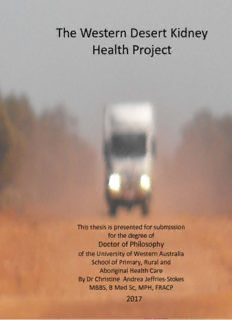
DOCTOR OF PHILOSOPHY - JEFFRIES-STOKES Christine Andrea PDF
Preview DOCTOR OF PHILOSOPHY - JEFFRIES-STOKES Christine Andrea
The Western Desert Kidney Health Project This thesis is presented for submission for the degree of Doctor of Philosophy of the University of Western Australia School of Primary, Rural and Aboriginal Health Care By Dr Christine Andrea Jeffries-Stokes MBBS, B Med Sc, MPH, FRACP 2017 I would like to thank the Aboriginal people of the Eastern Goldfields, especially the Wongutha, Mulba-Ngadju, Anagu, Ngalia and Kuwarra people for sharing their land, their culture, their wisdom, their hearts and their lives with me during this project. I would especially like to acknowledge my co-investigator, Annette Stokes, for her incredible hard work, her grace, her dignity, her patience and her friendship – without Annette this project truly would not have been possible. And Geoffrey, without whom I would never have found my home in the Goldfields. 1 2 2 Thesis Abstract The Western Desert Kidney Health Project - Health Status of Aboriginal and Non-Aboriginal Adults and Children in a Remote Area of Australia 3 4 The Western Desert Kidney Health Project - Health Status of Aboriginal and non- Aboriginal Adults and Children in a Remote Area of Australia The increasing burden of kidney disease and type 2 diabetes (T2DM) is a worldwide problem, especially for Indigenous populations. The average life expectancy at birth of Aboriginal Australians is significantly less than for non-Aboriginal Australians. National figures suggest the disparity in remote areas is even more marked. Contributing factors to this reduced life expectancy are the effects of T2DM, kidney disease, their associated conditions and complications. The Western Desert Kidney Health project (WDKHP) was an innovative research project that grew from the despair of the Aboriginal people of the Goldfields of Western Australia and their desire to understand more about diabetes and renal disease to reduce the effects these diseases are having in their communities. Aims The aims of the WDKHP were 1) To develop and evaluate community education and community development strategies to reduce the prevalence of the risk factors for T2DM and kidney disease, using a community arts for community development model. 2) To determine the prevalence of type 2 diabetes (T2DM), kidney disease and the risk factors for these diseases in Aboriginal adults and children in a remote area of Western Australia 3) To compare with prevalence rates for non-Aboriginal adults and children living in the same locations 4) To compare those prevalence rates with national rates 5) To determine the age at which the risk factors are appearing Methods The WDKHP was a community based participatory research project featuring annual cross sectional surveys over 3 years. It was conducted in 5 towns and 5 remote Aboriginal communities over lands of people of Western Desert Language groups – primarily Wongutha, Mulba-Ngadu and Anagu-Pitjantjatjara language groups. Participation was offered to all people regardless of age or ethnicity. The project involved Aboriginal researchers embedded in the community and extensive consultation and involvement of these communities with a pilot project to demonstrate the methods to the communities. A mobile research team made up of Aboriginal researchers, collaborating researchers, artists and medical students, spent 2 to 3 weeks annually for 3 years, starting in 2010, 5 in each of the study communities. Data collection included personal and family medical history, clinical assessment and investigations using point-of-care machines. Results Participation was good - 79% (n=818/1035) of the Aboriginal population (175 men, 250 women, 393 children) and 12% (n=297/2475) of non-Aboriginal population (74 men, 114 women, 109 children) completed at least one health assessment The WDKHP found higher than predicted rates of T2DM, hypertension, haematuria and elevated ACR in Aboriginal and non-Aboriginal adults and children. Prevalence of overweight and obesity were similar to national rates. Risk factors were found in children as young as 2 years. A difference in rates of disease between Aboriginal and non-Aboriginal people was not as marked as predicted. There was no difference between Aboriginal and non- Aboriginal children and no difference between participants living in towns compared to those living in remote communities. Aboriginal women were the highest risk group. More than 95% of Aboriginal participants had spent most of their lives in rural or remote areas but 91.5% of non-Aboriginal participants had grown up in urban settings. More than 400 people (37% of participants) responded to evaluation questionnaires. There was no negative feedback about the arts based strategies or the project in general, except for expressions of dismay that the project was limited to 3 years. Qualitative data demonstrated community change in behaviour although the study period was too short to demonstrate change in the biomedical markers. Conclusion Long term relationships with Aboriginal researchers embedded in the community, with cultural authority, who understand the cultural nuances and are able to engage the community leaders were a critical feature of this research. The innovative arts and community based engagement strategies contributed to good participation and community satisfaction with the project. The rates of T2DM, hypertension and markers for kidney disease for Aboriginal and non-Aboriginal participants were, in general, much higher than expected suggesting ethnicity might be less important that environmental and lifestyle factors. There was no increase in rates of disease or the biomedical markers during the study. More research is needed to examine potentially modifiable factors - food supply, exercise opportunities, water quality and living conditions, offering scope for interventions to reduce the risk and burden of these diseases. 6 2 DVD – Introduction to the Western Desert Kidney Health Project This DVD will assist the reader to develop a picture of the place and hear the voices of the people involved in this project so that the remainder of this thesis has meaningful context. 7 8
Description: